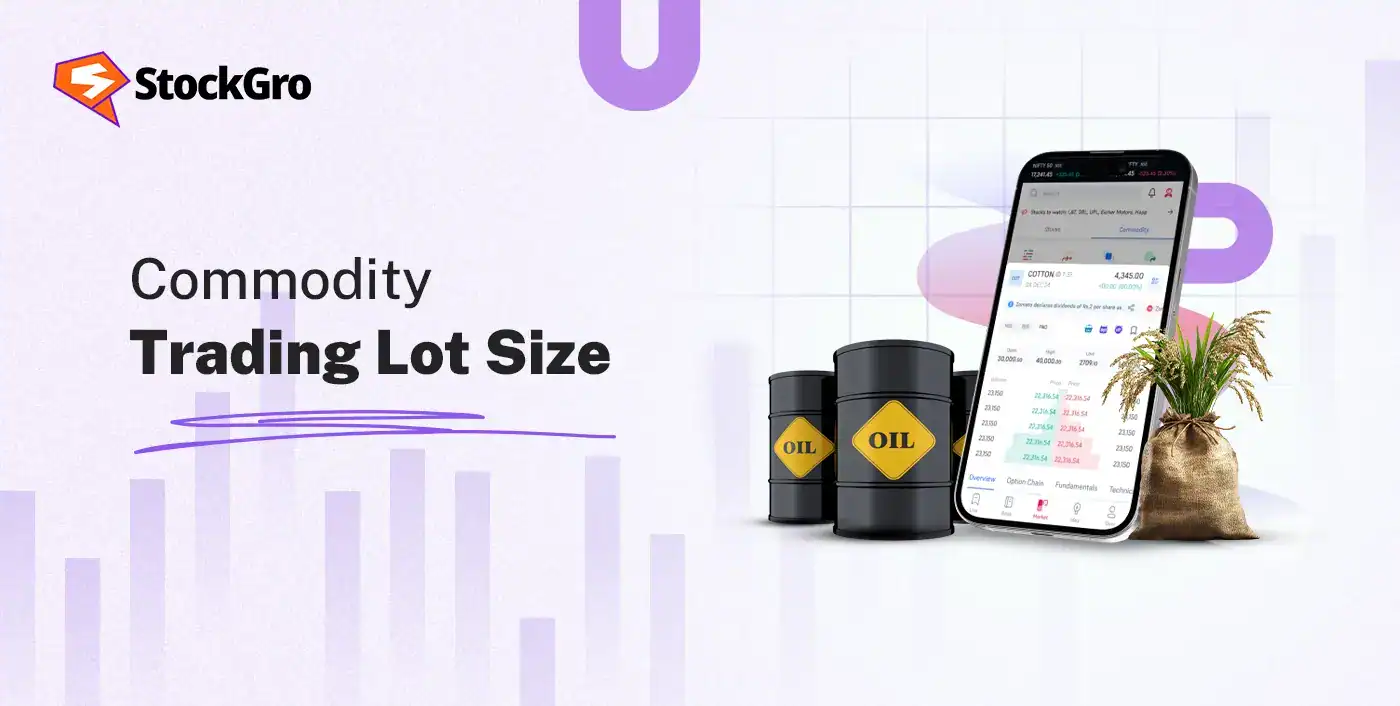
It’s pretty common for investors to feel confused when opening a commodity trading account and seeing contracts with large numbers and wondering, “How many units am I really dealing with?” The commodity trading lot size is the key here, it tells you exactly how much of the commodity you’ll trade per contract. Without understanding it, traders may risk more than they expect. In India, commodity derivatives turnover jumped nearly 87%, reaching ₹280.6 lakh crore in FY 2023-24, pointing to the remarkable level of engagement in the market. Knowing the right lot size helps traders manage their exposure and plan trades more effectively within their trading account.
What is Lot Size in Commodity Trading?
In commodity trading of futures and options, a lot size is the predefined minimum quantity of a commodity that must be bought or sold in a single contract. This quantity is not chosen by the trader but is standardised by the commodity exchange, a regulated platform ensuring transparent pricing and standardised contracts, ensuring uniformity in all trades.
For example, the lot size for a standard gold contract might be 1 kilogram, while for crude oil it could be 100 barrels. Many commodities also offer mini or micro contracts with smaller lot sizes, allowing broader participation. The chosen lot size directly influences the margin requirement and overall exposure, and exchanges may adjust these sizes periodically to maintain liquidity and balance in the market.
Why Lot Size Matters in Commodity Trading
The concept of lot size is fundamental in commodity trading for several reasons, which include the following:
- Standardisation and uniformity
Lot sizes create a consistent framework for trading. By standardising the quantity of a commodity in a contract, exchanges ensure that all market participants are trading under the same terms. This conformity makes trading easier and brings greater clarity to the market.
- Risk management
Lot sizes play an important role in risk management. By defining the minimum quantity of a commodity per trade, they directly impact the level of risk a trader is exposed to. A larger lot size means a greater financial commitment and, consequently, a higher growth possibility for both profit and loss.
- Price determination
The lot size of a commodity, in combination with the tick size (the minimum price movement of a trading instrument), determines the profit or loss per tick. This relationship is essential for traders to calculate potential returns and manage their positions effectively.
- Market liquidity
Standardised lot sizes contribute to market liquidity. When contracts are uniform, it becomes easier for buyers and sellers to find counterparties, leading to a more efficient and active market.
Commodity Lot Sizes in India (MCX & NCDEX)
The Multi Commodity Exchange (MCX) and National Commodity & Derivatives Exchange (NCDEX) are India’s two main exchanges for regulating commodity derivatives trading. Both were established in 2003 and function under the supervision of the Securities and Exchange Board of India (SEBI). They enable transparent price discovery, efficient risk management, and standardised contract settlement for traders, hedgers, and producers. SEBI regulates their operations under the Securities Contracts (Regulation) Act, 1956 and SEBI Listing and Disclosure Regulations, ensuring market integrity and investor confidence.
MCX primarily deals in metals, energy, and select non-agricultural commodities, while NCDEX focuses on agricultural products, encouraging farmer participation and quality standardisation. Both exchanges also determine the commodity trading lot size, the minimum tradable quantity for each commodity. Lot sizes are fixed based on factors such as market liquidity, price volatility, and delivery mechanisms, ensuring fairness and efficiency in contract design. In doing so, MCX and NCDEX not only facilitate trading but also define key parameters that shape market accessibility and strategy in India’s commodity markets.
Examples of Lot Sizes (Gold, Silver, Crude Oil, Agri)
Each commodity traded on India’s exchanges follows a fixed quantity per contract, known as its lot size. The lot sizes applicable by MCX and NCDEX for various commodities are discussed in this section.
The standardised MCX lot size for metal and energy commodities such as the gold lot size, crude oil lot size and others are as follows:
| Commodity | Lot size |
| Copper | 2,500 kgs |
| Gold | 1 kg |
| Silver | 30 kg |
| Crude oil | 100 barrels |
On the other hand, the NCDEX lot size for agricultural products are as follows:
| Commodity | Lot size |
| Soyabean | 5 MT |
| Chana | 10 MT |
| Steel long | 10 MT |
| Kapas | 4 MT |
How to Calculate Lot Size in Commodity Trading
Now that you’re familiar with commodity lot sizes in India, it’s important to learn how to calculate them for your trades. While each commodity has a fixed lot size on exchanges like MCX or NCDEX, traders often need to determine how many lots to buy or sell based on their risk tolerance and capital allocation. This ensures you do not overexpose yourself and can manage losses effectively.
To calculate the ideal lot size for a trade, consider the amount you are willing to risk and your stop loss in ticks. Use this formula:
Lot Size = Amount willing to risk ÷ Stop loss in ticks
For example, if you want to trade gold, where the gold lot size is 1 kg. You decide you are willing to risk ₹15,000 on this trade. After analyzing the market, you set a stop loss of 60 ticks. Using the formula:
Lot Size = ₹15,000 ÷ 60 = ₹250 per tick
If the gold price moves 1 tick, your profit or loss will change by ₹250. Knowing this, you can decide whether to take 1 lot, 2 lots, or adjust your trade size based on your total capital and risk appetite. This method applies to all commodities, including silver, crude oil, and agricultural products, ensuring precise risk management across trades.
Impact of Lot Size on Margin & Risk
The size of the lot you trade has a direct and significant impact on both the margin required for the trade and the level of risk you undertake. The major elements in this relationship include the following: Initial margin requirement:
- Initial deposit needed (margin): This is the sum you must deposit with your broker to open and maintain a trading position. The margin required is directly proportional to the size of your trade. Trading larger lot sizes increases both the gains and the margin required.
- Possibility for profit and loss: The commodity trading lot size is a primary determinant of your risk . A larger lot size amplifies both potential profits and potential losses. A small price movement in the market can result in a substantial gain or loss when trading with a large lot size. Conversely, a smaller lot size reduces the financial impact of price fluctuations, thereby lowering your risk.
- The magnifying effect on trades: Lot size directly affects leverage, allowing traders to manage a large position with relatively little capital. Leverage can boost profits, but it equally increases the scale of losses. Handling bigger lot sizes raises your leverage, which in turn heightens your exposure to risk.
- Balancing your trade capital: The lot size you choose can also affect your ability to diversify your portfolio. If you commit a large portion of your capital to a single trade with a large lot size, you may have limited funds available to invest in other commodities or assets, potentially increasing your overall portfolio risk.
Conclusion
When you enter the commodity market, you’ll notice you can’t just buy one gram of gold or a single barrel of oil. Trading is done in fixed, standard quantities called a commodity trading lot size. This is a fundamental rule set by exchanges. Understanding this concept is the first step to knowing how much capital you need for a trade, how to calculate your potential profit or loss, and how to properly manage your risk.
FAQs
Lot size in commodity trading is the fixed quantity of a commodity in one contract, standardised by exchanges to ensure uniformity. It defines how many units or quantities you must buy or sell in a single trade for that commodity.
Commodity lot size is determined by exchanges based on factors like market liquidity, price volatility, and delivery mechanisms. The goal is to standardise trading, improve market efficiency, and balance accessibility and risk for all market participants in various commodities.
In MCX, the standard lot size for gold is 1 kilogram, and for silver, it is 30 kilograms. These standardised quantities set the minimum traded units in each contract for these precious metals in the Indian commodity market.
Crude oil lot size in commodity trading on MCX is fixed at 100 barrels per contract. This standardisation allows traders to understand their exposure and margin requirements clearly for trading crude oil futures.
Lot size is crucial as it determines the minimum trade quantity, impacting margin requirements, profit/loss calculations, and risk exposure. It standardises contracts, ensuring market liquidity and aiding in effective risk management for traders trading commodity futures.
The lot size directly influences trading margins; larger lot sizes require higher margin deposits due to increased financial exposure. Traders must understand lot size to allocate capital efficiently, manage risk, and avoid overexposure in volatile commodity markets.
No, lot sizes are fixed and standardised by exchanges and cannot be altered by traders. However, smaller mini or micro contracts may be available for some commodities, allowing different participation levels within the predetermined lot size framework.

